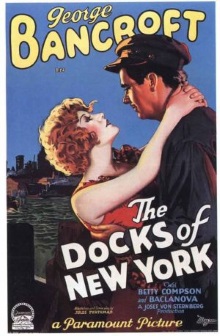
A few minutes into this second film on my upcoming course’s watch list, I can guess at some of the reasons why the professor picked it and the previous Street Angel. Both are silent films and both are ultimately love stories. Yet the two are very different films. Where the first film was elegant and timeless, The Docks of New York is gritty, dirty and very much rooted in the New York of the steam-ship era. The opening shot sets the tone for the whole movie: deep within the bowels of a ship, a gang of stokers shovel coal into the engines. Sweat runs down their bodies and drenches their shirts. Gravel and goal scrunches under their boots. The flame from their cigarettes and the fires of the engine cast stark shadows within the tight confines.
Such hard jobs can be done only by hard men. It’s no surprise that such men play hard as well during the short time that they have for shore leave. On one such night, our protagonist Bill Roberts saves a beautiful woman who had jumped into the sea from drowning by happenstance. To warm her up, he takes her into a pub by the wharf that is bustling with sailors and prostitutes. Naturally the two strike up a relationship, but will it last beyond a single night?
As noted above, The Docks of New York impresses with its detailed recreation of a seedy dock-side scene. There is a real sense of place here, complete with a lived-in quality. Contrast this with Street Angel which always felt like it was set on large, elaborate theatrical stages. It’s filled with real people too, people whose clothes tear, who get wet, who get drunk and who get dirty. It is almost a shock to see George Bancroft, the actor who plays Bill, really jump into the water. The sense of verisimilitude is even heightened by how it takes place in almost real-time. All of the events in this film take place over the course of a single night.
It doesn’t quite go the full distance towards naturalistic cinema of course. The acting still has a theatrical quality to it, though much muted compared to Street Angel. But in it, you can already see how films are evolving away from romanticism. The tawdry setting and unsavory characters only reinforce the movement towards realism. As my wife noted, the dress that Betty Compson, who plays the rescued girl, changes into inside the pub seems scandalously transparent. We are very far indeed from the chaste lovers of the previous film.
Unfortunately while I appreciated the insight into the history of cinema that watching this brought, I don’t find myself really entertained by it. The plot is thin, almost non-existent, and of course the modern world has no shortage of gritty settings and dark stories. This film’s ending is ultimately and predictably romantic as well, which seems like almost an amateurish joke after they tried so hard to root things down in grimy reality. The escapism of Street Angel still affords it some novelty value to modern audiences I think, but the half-measures of The Docks of New York have nothing much to offer.